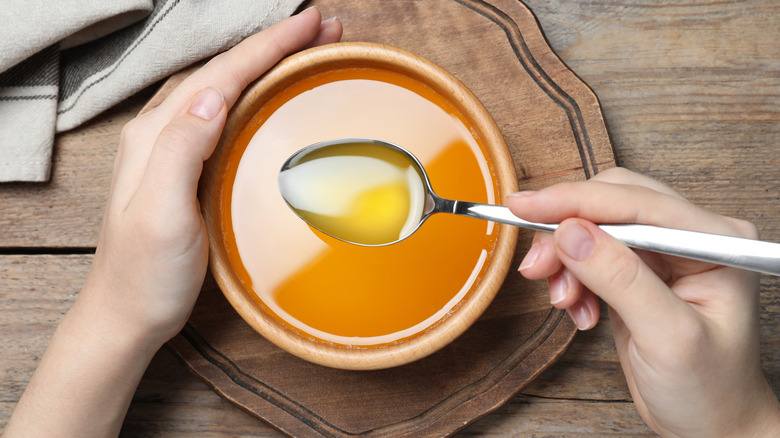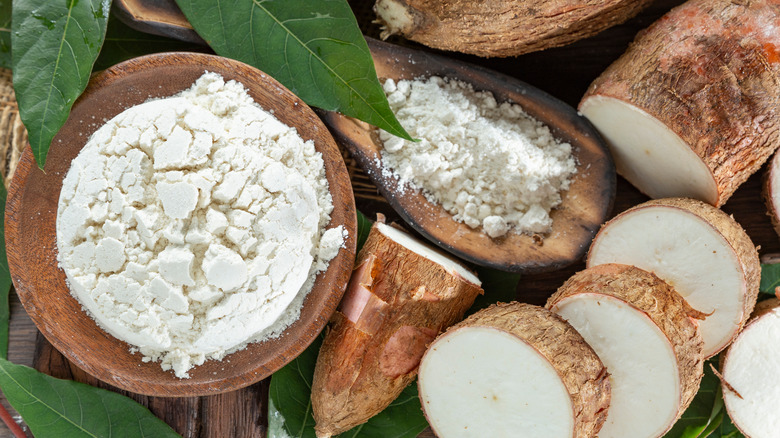The Secret Ingredient To Make Your Sauces Glossy
The perfect sauce may not exist, but that doesn't mean striving to perfect any sauce recipe is a futile effort. Modern sauce recipes are the result of generations of experimenting with flavors, textures, aromatics, and aesthetics in pursuit of perfection. We finetune seasonings and spices, add fats and oils for richness, and use various bases from tomatoes to egg yolks, yet the flavor is only one dimension of a perfect sauce. We use reductions and thickening or coagulating agents to alter the texture and infuse it with herbs to give off appetizing aromatics. And of course, for an aesthetically perfect sauce, we use ingredients and techniques to get a perfect glossy sheen.
For certain foods like chocolate, luster comes with tempering, which is the act of "heating and cooling chocolate to stabilize it for making candies and confections," says Ghiradelli Chocolate. Tempering chocolate essentially molecularly shuffles the fatty acids in chocolate so that they reform in a more stable structure, giving the chocolate a more smooth and glossy finish as well as a higher melting point. However, tempering doesn't work the same way on heartier sauces like gravies, soups, custards, and condiments, so instead, cooks have to resort to a few secret ingredients that'll help enhance a sauce's gloss.
Get a better shine with butter
One of the easiest ways to enhance your sauce's gloss is to add butter because simply put, fats make things glossy. In addition to flavor, cooking oils and melted fats add luster to the dish, especially in sauces. Butter and fats can be easily incorporated into a recipe, though there is some debate over when butter should be melted, softened, or cold when it's added. Either way, butter is great as a final touch in cheese dips, caramel sauces, and gravies to give the sauce just a touch of creamy flavor and sheen.
The only problem with only using butter and fats to add shine to the sauce is their actual flavors. If the flavors of your sauce are already perfectly balanced, adding too much butter, especially salted butter, can throw the flavors out of whack, as well as cause your sauce to break, so use it sparingly to add just a little richness and glossy texture (via PureWow).
Overall, butter is a last-minute enhancement to make a sauce presentation-ready, but to curate a glossy sauce from the start of the recipe, consider the thickeners that are used to give the sauce body from the beginning.
Add sheen to your sauce with starch
For sauces like gravy and béchamel, which need a thickening agent, it's important to pick the right starch for the job. According to The University of Illinois, cornstarch is the most common thickener, because it gives a shiny appearance to sauces, contrary to flour which can cause the sauce to become more opaque. This is because cornstarch becomes translucent when heated, but it can only achieve full glossiness if it doesn't lump in the sauce. To avoid lumps, starches need to be thoroughly emulsified into butter (making a roux) or liquid (making a slurry) before they are added to the sauce. Doing so prevents the starch from clumping together and allows it to distribute evenly through the sauce.
Though cornstarch is popular, some of the experts at MasterClass recommend experimenting with tapioca starch because it's gluten-free, heightens sauce gloss, and thickens at a lower temperature. Tapioca starch comes from the cassava root, a South American tuber vegetable, and is used for thickening anything from puddings to sauces, to stews. Similar to cornstarch, it also turns translucent when emulsified, but tapioca starch can absorb liquids before they're boiling, making it better for use in low-heat dishes, or recipes with a shorter bake time. Cornstarch, on the other hand, is more heat-resistant and better utilized as an early-recipe thickener. Either way, adding a well-emulsified starch to your sauce will not only help hold it together, but it'll also elevate the overall sheen.


